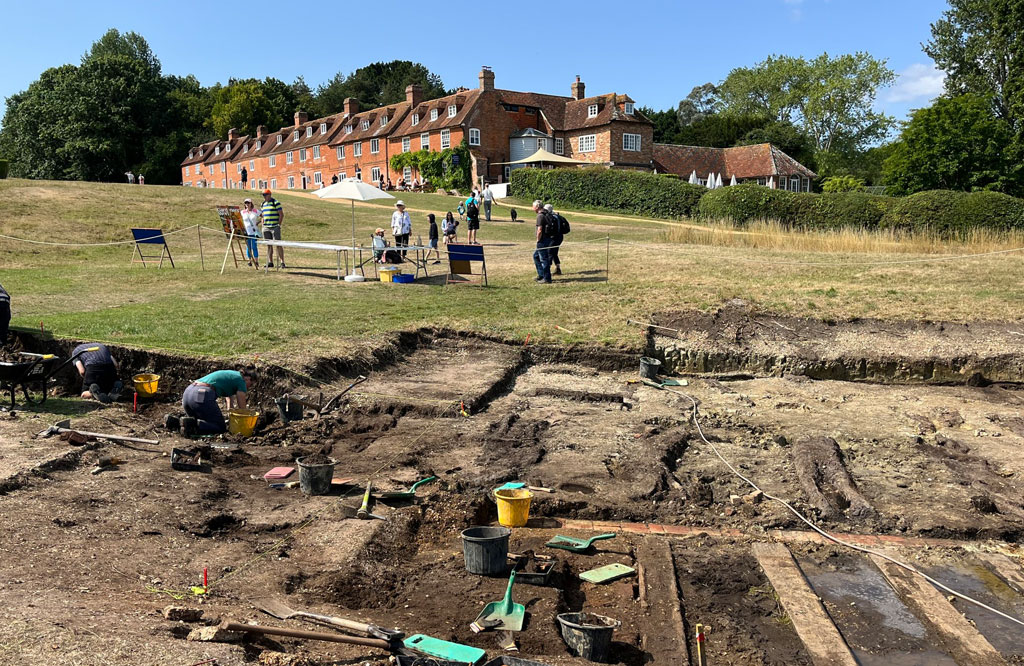Slipways Archaeology

The slipways were in use from around 1740 until 1971 when the boatyard operations moved upstream, leaving the historic site to be preserved and undisturbed. They are a rare survivor of such dockyard structures, most of which have been built over in cities and towns.
The site has immense historical and archaeological importance, offering insights into maritime construction techniques, industrial practices, and the logistical infrastructure from medieval times, huge wooden shipbuilding, for landing craft in WW2 and to modern boatbuilding.
This is part of a long-term plan to understand the shipyard’s historic development by doing extensive archaeological surveys. These will feed into a project to create a ship ‘sculpture’ based on HMS Agamemnon, in the no 2 slipway, using the original ships plans, contract and data from the shipwreck in Uruguay to inform the design and construction.
Buckler’s Hard presents a uniquely preserved site that can inform our understanding of shipyard infrastructure, construction techniques and the workforce community.
1993 to 1998
In 1993 to 1998 all the slipways and quay area were surveyed for the first time by the Hampshire and Wight Trust for Maritime Archaeology and the University of Southampton. A comprehensive topographical and geophysical survey was conducted as well as partial excavation of slipway 1 with diver investigation at the ends of slipway 1 and 2, and a probe survey to establish the extent of the remaining structures. In the following years test pits were dug and slipway 1 to the north was excavated to reveal the huge groundway timbers one on top of each other.
The wooden structures showed timber aligned parallel to the water in two rows running from the land towards the water. There was a gap between these two rows of timbers leaving space for the keel blocks running longitudinally in the slipway and perpendicular to the water. Underwater excavation showed these well-preserved structures continuing into the water well below the high-water mark.
2025

In summer 2025 the Buckler’s Hard Shipyard Trust undertook a new archaeological dig and survey of the largest no 2 slipway.
During three weeks in summer 2025 the dig was overseen by University of Southampton, Centre for Maritime Archaeology Department under Professor Jon Adams and Dr Rodrigo Ortiz-Vazquez, with supporting students and volunteers from the New Forest National Park Authority, the Maritime Archaeology Trust, local volunteers and community members. It has been funded through the Buckler’s Hard Shipyard Trust through donations and with help from the Beaulieu Estate and contractors Pete and John Niccolls.
Working above the intertidal limit in the slipway area, 17 groundway timbers were found set out at the upper part of the slope under around 60cm of topsoil and 20cm of sediment in the lower area. In the waterlogged area, the timbers were well preserved, further up the hill the timber was increasingly degraded, and some appeared to have been removed, with evidence of backfill. In the centre, the timbers became larger, whole or half trees laid flat, some over a meter wide and 6 metres long, around 120cm apart and occasionally with outer tree bark still intact. There was evidence of iron fixings and treenail holes. Samples were taken from those timbers to be dated using dendrochronology.
The full width of the slipway was established by the revealing of the two side walls with upright posts and boards making for a total width of 13.5m. The angle of the slipway relative to the river edge was discovered to be angled more upstream, so that ships could launch across the bend of the river at its widest reach.
The Maritime Archaeology Trust’s Director Garry Momber did a number of georeferenced drone photogrammetry surveys to record all the features and locations of the structures. Accordingly, a base line has now been established for future monitoring.
A huge amount of ‘finds’ were uncovered, including iron nails, staples, copper plate, tools, ceramics, glass, bottles, clay pipes, bones and a lot of 20th c debris from the time when the slipway was used in WW2 and things thrown into the area by passing visitors.
These finds have been recorded and kept as part of the Maritime Museum collection and a free special exhibition on the dig is on display until March 2026 in the Shipyard Gallery.
Following the dig, the area has been backfilled to protect the structure.
We will return in July/ August 2026 to survey and record the lower part of this same slipway in the intertidal areas where we anticipate that the timbers will be even better preserved and find more evidence and finds.
Contact us to volunteer if you are interested to join in.


